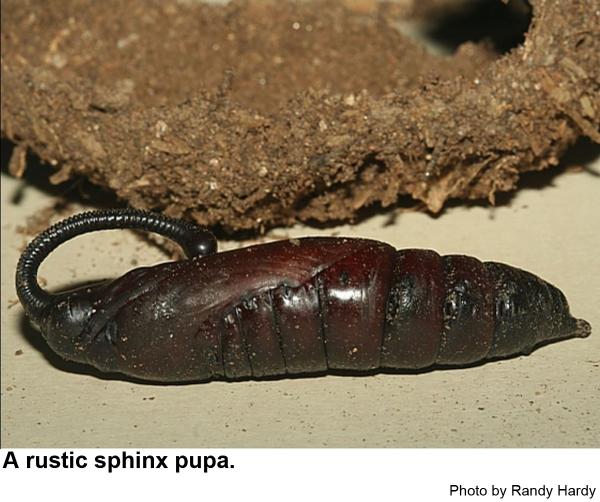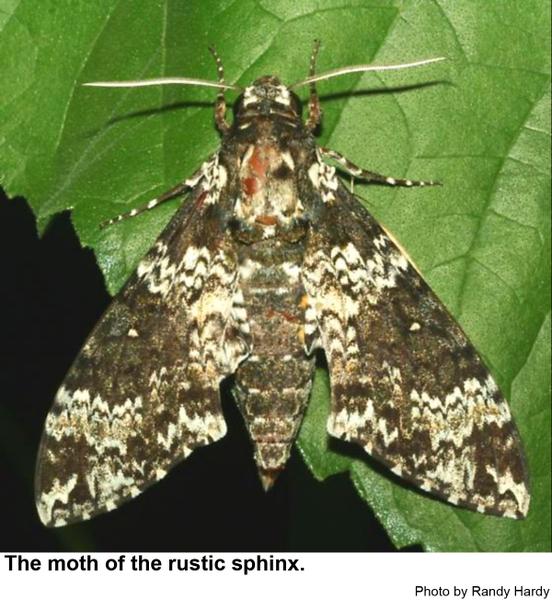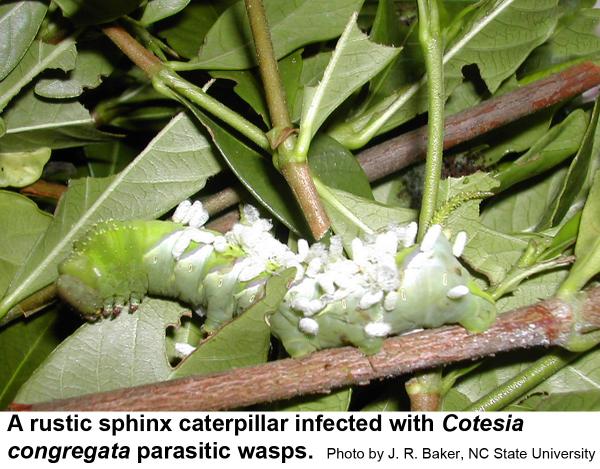Description and Biology
The rustic sphinx, Manduca rustica, is a moth in the same genus as the tobaccofly (tobacco hornworm) and the tomato hornworm. These moths are moderately large (wing span from 31/2 to almost 6 inches) with heavy bodies and are usually nocturnal, feeding late at night. Rustic sphinx moths are mottled and zig-zagged with black and white or very dark brown and white markings except for three pairs of yellow spots on the abdomen that are usually covered by the wings. When at rest, the wings are held slightly away from the body forming an isoceles triangle. Each wing has a large, dark area on the outer margin with a tiny white dot in the middle. Females lay one to five eggs on the undersides of host leaves. A large female can lay up to 2,000 eggs! Tiny caterpillars hatch about four days later. The rustic sphinx caterpillar is bright green with white to yellow diagonal stripes bordered with darker green to purple-black on the top of each stripe. The horn at the end is harmless and has tiny bumps that help distinguish the rustic sphinx from other hornworms. The head and upper thorax also have tiny bumps. The color and pattern is constant as the hornworm molts and grows. After three weeks, the upper surface becomes light reddish-brown just before the caterpillar crawls down to pupate in the soil. Rustic sphinx caterpillars are often found in the "sphinx position" (When disturbed, they hold onto the plant and raise their heads and thoraces to more or less resemble the ancient Egyptian Great Sphinx). Mature caterpillars tunnel into the soil, make a cavity, and then pupate within. The pupae are tapered on each end and very dark brown. The mothparts form a loop on the lower surface. About three weeks later, new moths emerge from the pupae and dig out to continue the wheel of existence. The last generation of rustic sphinx caterpillars form overwintering pupae. We have at least two generations per year here in North Carolina although several broods occur from May-October further south.
Host Plants
Rustic sphinx caterpillars have been found feeding on American beautyberry, ash, basil, butterfly bush, crape myrtle, cross vine, desert willow, forked bluecurls, fringe tree, gardenia, heliotrope, jasmine, lantana, ligustrum, lilac, olive, sesame, and sunflower. The moths visit just about anything in bloom at night including flowers with deep corollas such as petunia.
Residential Recommendations
Rustic sphinx caterpillars are plagued by a tiny wasp, Cotesia congregata, the larvae of which develop inside the hornworm before chewing out and spinning tiny cocoons that are fastened to the worm. Other predators and parasites also infest rustic sphinx eggs, caterpillars, and pupae. Because this is a sporadic pest, it would be unwise to apply an insecticide prophylactically. Large numbers devouring a plant can be hand picked and trampled underfoot. Any insecticide labeled for landscape use should give more than adequate control.
Other Resources
- Common name: rustic sphinx, scientific name: Manduca rustica (Fabricius) (Insecta: Lepidoptera: Sphingidae). Byron, M. A. and J. L. Gillett-Kaufman. 2019 (reviewed). Featured Creatures. Entomology & Nematology, FDACS/DPI, EDIS. Publication Number: EENY-652
- Manduca rustica rustica, man-DOO-kuhMruh-STICK-kuh, Rustic Sphinx (Fabricius, 1775) Sphinx. Oehlke, B. 2019. P.E.I. Retired Teachers Association.
- Manduca rustica (Fabricius, 1775). Anonymous. 2023. Butterflies and Moths of North America.
- Extension Plant Pathology Publications and Factsheets
- Horticultural Science Publications
- North Carolina Agricultural Chemicals Manual
For assistance with a specific problem, contact your local Cooperative Extension Center.
This Factsheet has not been peer reviewed.
Publication date: July 18, 2019
Reviewed/Revised: April 24, 2024
Recommendations for the use of agricultural chemicals are included in this publication as a convenience to the reader. The use of brand names and any mention or listing of commercial products or services in this publication does not imply endorsement by NC State University or N.C. A&T State University nor discrimination against similar products or services not mentioned. Individuals who use agricultural chemicals are responsible for ensuring that the intended use complies with current regulations and conforms to the product label. Be sure to obtain current information about usage regulations and examine a current product label before applying any chemical. For assistance, contact your local N.C. Cooperative Extension county center.
N.C. Cooperative Extension prohibits discrimination and harassment regardless of age, color, disability, family and marital status, gender identity, national origin, political beliefs, race, religion, sex (including pregnancy), sexual orientation and veteran status.




